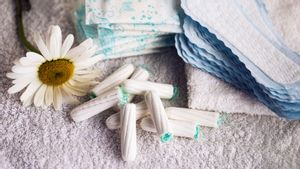A majority of women face muscular cramps and period pain, medically known as dysmenorrhea, throughout the reproductive years. Cramps refer to a throbbing pain in the lower abdomen that attacks women as PMS (pre-menstrual syndrome) up to a week before the onset of their periods—and sometimes, even during it. For some women, period pain is unbearable and, in certain cases, extreme pain can interfere with their daily chores. Some other symptoms of PMS include fatigue, pain in the back and legs, diarrhoea, nausea, and vomiting.
Causes of period pain
When you menstruate, the uterus contracts to shed its lining. Hormone-like chemicals known as prostaglandins stimulate muscle contractions in the uterus and are responsible for pain and inflammation. Higher levels of prostaglandins are responsible for intense menstrual pain. If the uterus is contracting too strongly, it can press against blood vessels, cutting off the supply of oxygen to the muscle tissue. Pain is felt when a muscle loses its oxygen supply for a brief time.
How to reduce period pain?
The best way to manage these exhausting cramps is by inhibiting the release of prostaglandins naturally. Here are some tips on how to get rid of period pain:
1. Avoid junk food
According to the NCBI research, high consumption of junk food provides excess amounts of energy, fat, sugar, and sodium to the body, which are associated with an increased risk of dysmenorrhea, especially in young women. High sugar, salt, and preservative content increase inflammation during periods, thus intensifying pain. Vegetable oil in junk food is another culprit that can be worsening your situation. It is advisable to stop the consumption of junk food to avoid hormonal imbalance during periods.
2. Stay away from coffee and sugar
It is recommended by Dr Jolene Brighten, NMD (Functional Medicine Naturopathic Physician) that eliminating sweet-tasting foods and caffeine-containing beverages from your diet, particularly coffee can help in reducing menstrual pain and symptoms of PMS. Caffeine is a vasoconstrictor, which means it narrows the blood vessels, including the blood vessels in the uterus. So, it further deprives the oxygen-starved uterus of O2, leading to exaggerated pain. Moreover, caffeine is a diuretic. It can dehydrate you, making you feel even more exhausted and weak.
3. Increase your magnesium intake
Increasing magnesium intake serves as a natural menstrual cramps remedy. According to research, magnesium is more effective than drugs in lowering prostaglandins and relaxing muscles, thus reducing menstrual pain. Consume more nuts and seeds as they are rich sources of magnesium.
Additionally, you can also take a magnesium supplement after discussing it with your gynaecologist or nutritionist. However, avoid the supplement if you are prone to period diarrhoea, because the laxative properties of magnesium can worsen it.
4. Rely on green tea
Green tea is a great remedy to treat menstrual cramps. It is packed with antioxidants and possesses anti-inflammatory properties because of the presence of a compound called catechin, which makes you feel relaxed. NCBI research also states that drinking green tea is associated with reduced symptoms of dysmenorrhea. However, excessive tea is not advisable as it can inhibit the absorption of iron. You can easily consume two to three cups throughout the day.
5. Chamomile can help too!
Chamomile tea—and even capsules—are highly recommended as they have the ability to reduce the severity of dysmenorrhea by relieving pain. According to NCBI research, chamomile flower reduces inflammation in the body and has anticonvulsant properties. Therefore, it is used in spasms and as an effective anti-inflammatory solution.
6. Sesame seeds are a great addition to your diet
These small seeds are known for their inflammation calming abilities and thus play a vital role in reducing menstrual cramps. According to studies, women who consume sesame seeds regularly exhibit lesser pain due to dysmenorrhea. The huge quantities of zinc present in sesame seeds reduces inflammation and allows more oxygen to flow to the uterus.
7. Trust ginger to help you out
Ginger tea is an age-old home remedy for menstrual cramps. Ginger is anti-inflammatory and can thus help with pain and inflammation in the body. A great solace for menstruating women, a study found that ginger was as effective as ibuprofen in relieving menstrual cramps. Both ginger soup and ginger capsule are good to go.
8. Turmeric tea can be effective too
NCBI research states that the wonder compound curcumin, found in turmeric, is great for attenuating the severity of PMS symptoms and pain due as it modulates of neurotransmitters in the body, and also because of its anti-inflammatory property. It also inhibits the activity of inflammatory enzymes like COX and LOX, thus reducing the production of prostaglandins.
Moreover, because of its antispasmodic and antioxidant properties, it eases pain. Turmeric is one of the most effective menstrual cramps remedy. You can also mix ginger and turmeric together for better results and faster relief.
9. Yoga can ease cramps
Yoga can considerably reduce the severity and duration of dysmenorrhoea as stated in NCBI findings. Certain yoga poses can help in coping with unbearable cramps and can be practiced safely on heavy menstrual days. Stretch for around 30 to 60 seconds but do not push your body to the point of pain and discomfort.
10. If all else fails, resort to heat therapy
NCBI researchers advocate the effectiveness of heat therapy in dysmenorrhea. Drinking hot fluids or keeping a heating pad over the abdomen relaxes the muscles, thus reducing pain.
11. NSAIDS
Non-steroidal Anti-inflammatory Drugs (NSAIDs) are considered as primary treatment for primary dysmenorrhoea according to medical research. If there is just one question hovering in your mind that how to reduce menstrual pain instantly, NSAIDS is the solution. However, it is advisable to try the above remedies first and if you are not relieved from intolerable pain, then opt for NSAIDS after consulting the doctor. NSAIDS have adverse side effects including indigestion, headaches, and drowsiness.




